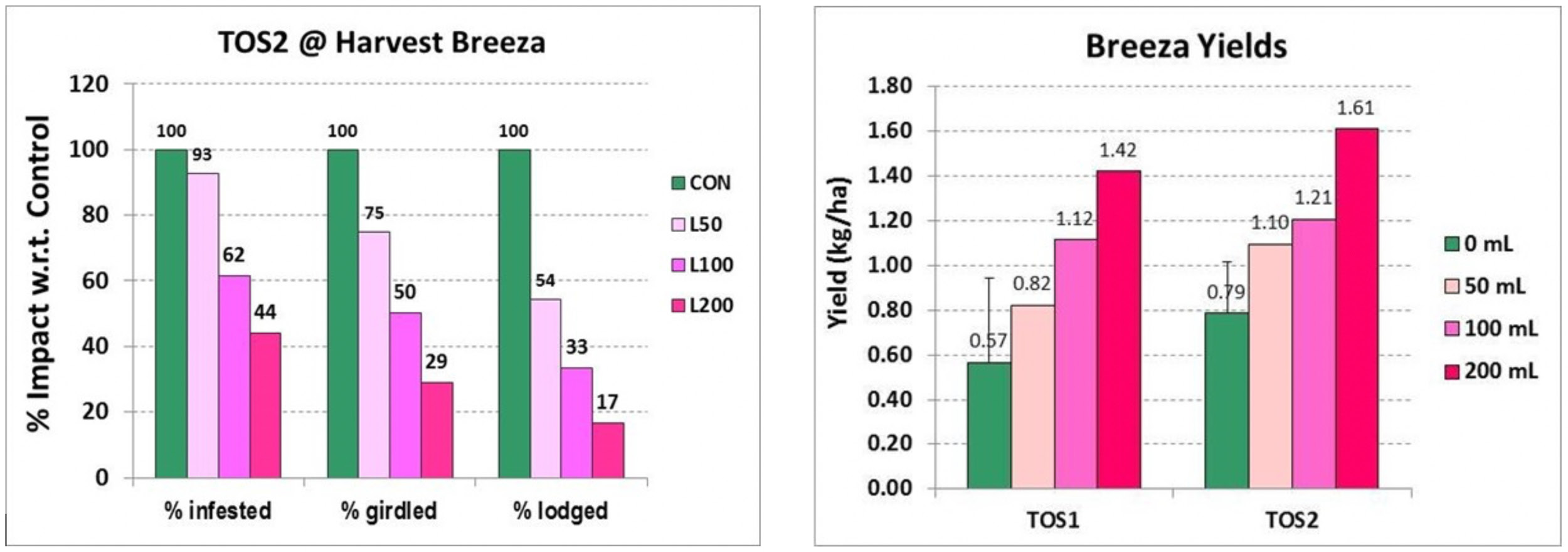Soybean seed treatment for lucerne crown borer
In the 2015/16 and 2016/17 summers, lucerne crown borer (aka Zygrita) caused extensive damage to soybean crops in the Bundaberg and North Coast NSW areas.
Read Hugh Brier's Beatsheet blog post to learn more about Zygrita.
The systemic insecticide, fipronil, is an effective seed treatment and is registered for use in soybeans. Check the permit for instructions on its use:
No insecticides are registered for control of adult Zygrita or for spraying on the crop.
In this short video, Andrew McDonald outlines the use of seed treatment to protect your soybean crop.
Research trials confirm efficacy of insecticide seed treatment
Soybean trials conducted by DAF entomologist Hugh Brier at Breeza, with support from NSW DPI agronomist Kathi Hertel, in 2016 targeted lucerne crown borer, which were inflicting major damage in many NSW crops and in some Qld coastal crops.

The control option tested was Legion, a fipronil-based product specifically for seed treatments. The trial included a range of rates including the 200 mL per 100kg of seed, that was shown to be successful in the US against an equivalent stem borer.
Locally there was scepticism that a seed dressing would provide sufficient control, but the results were astounding. At a site where over 80% of plants were infested, the 200 mL rate reduced infestation by 56%, severe damage (girdling) by 71%, and extreme damage (lodging) by 83%. The net impact was to double the yield, compared to the untreated control. (Figs 1 & 2).

Figure 1 (left): Percentage of infested/girdled/lodged soybean plants relative to the untreated control. The Legion treatments were seed dressings at 50, 100 & 200 mL/ 100 kg of seed.
Figure 2 (right): Harvested yields for soybeans infested with lucerne crown borer (Zygrita diva) in Breeza trials TOS1 and TOS2. Legion rates are as in figure 1. Bars shown are LSD bars.
After the permit for Legion was secured for crown borers in soybeans, it has been used by 50% of growers in the Northern Rivers of NSW, and in all the NSW breeding trials.
Other potential benefits of insecticide seed treatments
The other potential use for seed dressings is to control early infestations of phytoplasma-vectoring leafhoppers including those in the phloem-feeding genus Orosius.
A current trial aims to evaluate a range of seed treatments (fipronil-based, as well as two neonicotinoid products), not only against crown borer, but also against potential phytoplasma vectors, as well as other sucking pests including aphids and mirids.
The trial will also compare products applied as a seed treatment or as an in-furrow spray, the former being more costly and time-consuming to apply, but often more effective against target pests.
Trial results as of Feb 2019: Assessments of crown borers (inside stems) are yet to be taken, but early beat sheet sampling of the canopy at 35 DAE (days after crop emergence) shows significant treatment effects for jassids.
While 98% of the jassids present were the bright green vegetable (Austroasca viridigrisea), which are not reported phytoplasma vectors, the data is a useful indicator of the treatment's effectiveness against this group of sucking pests. Interestingly, the only products to reduce jassid numbers were the seed treatment formulations of the neonicotinoids, imidacloprid and thiamethoxam. This is the reverse of what we have seen in other crown borer trials, where neonicotinoid products are not effective against this pest.
The latest data suggests the significant reduction in vegetable jassids at 35DAE by the neonicotinoid seed treatment products is not observed at later crop ages, there being no significant treatment differences at 48 and 58 DAE (DAE = days after plant emergence).
No significant impacts on mirid populations were observed at any date. Impacts on predators are still being assessed.
Watch this space for further data.
End of season crown borer management
If crown borer has been present in the crop, The Beatsheet Blog recommends that growers break the life cycle by preventing pupae from successfully overwintering by:
-
Controlling volunteer soybeans and weed hosts such as budda pea, sesbania and phasey bean to reduce the numbers of lucerne crown borer overwintering in or near future plantings.
- Using cultivation to bury and/or split the soybean stubble disrupts pupation. Strategic tillage assisted by GPS steering allows tillage to be confined to narrow strips along the old plant rows. It is no coincidence that lucern crown borer activity is greatest in zero till paddocks. The burying of the stubble to >10 cm also helps to suppress soil borne diseases such as phomopsis and charcoal rot, which are favoured by zero till.
Read Pulse Check blog articles | Pulse Check Coastal facebook | Subscribe to the monthly newsletter

